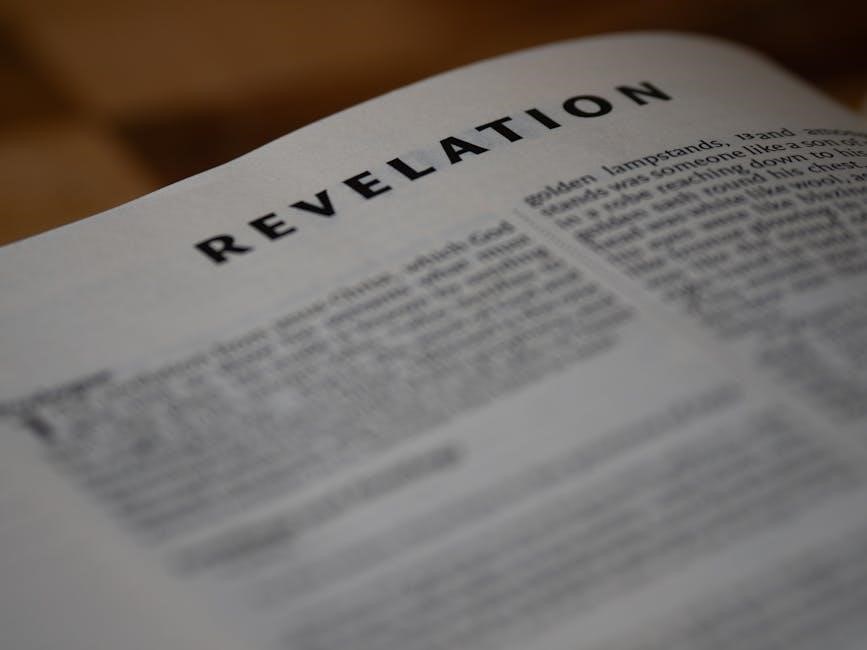The Book of Revelation, written by John, is a prophetic vision of the end times․ It includes letters to seven churches, symbolic visions, and the ultimate triumph of God, encouraging perseverance and faith among believers․
1․1 Overview of the Book
The Book of Revelation, written by John, is the last book of the Bible and the only one classified as apocalyptic literature․ It contains prophetic visions of the end times, including letters to seven churches, symbolic representations of future events, and the ultimate triumph of God․ The book is structured around the opening of seven seals, trumpets, and bowls of wrath, culminating in the return of Jesus Christ and the establishment of a new heaven and earth․ Its central theme is the sovereignty of Jesus Christ and God’s ultimate victory over evil․ The book serves to encourage believers to persevere through trials and remain faithful, emphasizing the importance of obedience and worship․
1․2 Historical Context and Authorship
The Book of Revelation is traditionally attributed to John of Patmos, though debates exist about whether this refers to John the Apostle or another John․ Written during Emperor Domitian’s reign (95-100 AD), it addresses early Christian persecution․ Exiled on Patmos, John received visions to encourage resilience․ Composed in Greek, it was directed to seven churches in Asia Minor facing trials․ The text reflects the apocalyptic genre, blending symbolism and prophecy to inspire hope amidst adversity․ Its authorship, while debated, remains a cornerstone of Christian eschatology, guiding believers through historical and future challenges․ The book’s origins and context underpin its enduring relevance and theological depth․
1․3 Purpose and Audience
The Book of Revelation was written to encourage resilience and faith among early Christians facing persecution and hardship․ Its purpose is to inspire hope by revealing God’s ultimate triumph over evil and the promise of Christ’s return․ The audience includes the seven churches in Asia Minor, addressed individually in chapters 2-3, as well as believers across all generations․ The book serves as both a warning against compromise and a reminder of God’s faithfulness․ Its vivid imagery and apocalyptic visions were designed to strengthen the church, urging believers to remain faithful amidst trials and to trust in God’s sovereign plan․ This message of hope and perseverance remains timeless․

Structure of the Book of Revelation
Vivid visions, letters to churches, and apocalyptic judgments reveal God’s plan․ Structured around seven seals, trumpets, and bowls of wrath, it progresses to the New Heaven and Earth․
2․1 Letters to the Seven Churches (Chapters 2-3)
Jesus Christ commands John to write letters to seven churches in Asia, addressing their spiritual condition․ Each letter commends faithfulness, exposes shortcomings, and urges repentance․ Ephesus is praised for perseverance but warned to reclaim lost love․ Smyrna is encouraged to remain faithful during persecution․ Pergamos is rebuked for compromising beliefs․ Thyatira is commended for growing in love but admonished for tolerating false teachings․ Sardis is called to awaken from spiritual complacency․ Philadelphia is praised for fidelity and promised divine protection․ Laodicea is rebuked for lukewarm faith, urged to repent, and reminded of Christ’s desire to dwell among them․ These letters serve as timeless exhortations to believers to remain faithful and obedient․
2․2 The Throne Room Vision (Chapter 4)
In Chapter 4 of the Book of Revelation, John is transported to a throne room in heaven․ He sees God seated on the throne, described as resembling jasper and carnelian, with a rainbow around it․ The throne is surrounded by four living creatures, each with distinct features: a lion, an ox, a man, and an eagle․ Additionally, there are twenty-four elders dressed in white, wearing crowns, and holding harps․ They fall before the throne, casting their crowns and worshiping God․ The scene emphasizes God’s sovereignty and the heavenly worship, highlighting the reverence and adoration directed toward the Almighty, underscoring divine authority and eternal praise․
2․3 The Seven Seals (Chapters 5-7)
The opening of the seven seals by the Lamb in Chapters 5-7 unleashes a series of judgments upon the earth․ The first four seals release the Four Horsemen of the Apocalypse, symbolizing conquest, war, famine, and death․ The fifth seal reveals martyred believers crying out for justice, while the sixth seal brings cosmic disturbances and chaos․ The seventh seal introduces the Seven Trumpets, amplifying the judgments․ These seals depict a progression of divine judgment, emphasizing God’s sovereignty over history and humanity․ The seals serve as a warning of impending wrath and the importance of spiritual preparedness, highlighting the consequences of rejecting God’s redemption․
2․4 The Seven Trumpets (Chapters 8-11)
The seven trumpets, sounded by angels in Chapters 8-11, signify escalating judgments upon the earth․ The first four trumpets target creation: hail and fire destroy vegetation, a mountain of fire devastates the sea, a star poisons rivers, and darkness plagues the earth․ The fifth trumpet releases locusts that torment the unrepentant, while the sixth trumpet results in the deaths of a third of humanity․ Between the sixth and seventh trumpets, John is given a scroll to eat and prophesy anew․ The seventh trumpet declares the establishment of God’s eternal kingdom․ These judgments emphasize divine authority and the inevitability of God’s final victory over evil, urging believers to remain faithful amidst tribulation․
2․5 The Seven Bowls of Wrath (Chapter 16)

The seven bowls of wrath, poured out in Chapter 16, represent the final judgments of God before Christ’s return․ Each bowl unleashes severe plagues: painful sores, the sea turning to blood, rivers becoming bitter, scorched earth, darkness and pain, the Euphrates drying up, and a devastating earthquake with hail․ These judgments intensify the earlier trumpet judgments, culminating in the battle of Armageddon․ The bowls highlight God’s justice and the consequences of rebellion․ They serve as a climax to the end-time judgments, emphasizing the urgency of repentance and the ultimate triumph of God over evil, leading to the fall of Babylon and the establishment of His eternal kingdom․
Theological Themes in the Book of Revelation
The Book of Revelation explores God’s sovereignty, justice, and mercy, emphasizing the ultimate triumph over evil․ It highlights the struggle between good and evil, divine judgment, and the hope of eternal life with God, reinforcing faith, perseverance, and worship as central responses to God’s revelation․

3․1 The Sovereignty of Jesus Christ
The Book of Revelation underscores the sovereignty of Jesus Christ as the central theme, portraying Him as the Alpha and Omega, the Lamb who was slain, and the exalted King of Kings; His authority is evident in His role as the ruler of history, the judge of all nations, and the redeemer of His people․ The vision of the throne room (Chapter 4) and the Lamb who opens the seven seals (Chapter 5) emphasize His divine authority and power․ Jesus’ sovereignty is further highlighted in His triumph over evil, as seen in His victory over the beast and the final judgment, reinforcing His reign over all creation․
3․2 The Ultimate Triumph of God
The Book of Revelation culminates in the ultimate triumph of God over evil, showcasing His divine plan to restore creation․ This victory is demonstrated through the defeat of the beast, the false prophet, and Satan, who are cast into the lake of fire․ The final judgment ensures justice, and God’s sovereignty is fully established․ The vision of the new heaven and new earth symbolizes eternal restoration, where God dwells with humanity in perfect harmony․ This triumph reinforces God’s faithfulness to His promises, offering hope and assurance to believers of His eternal reign and the eradication of suffering, death, and sin․
3․3 The Role of the Church in the End Times
The Book of Revelation emphasizes the Church’s role as a witness to God’s truth and a source of encouragement during challenging times․ Believers are called to remain faithful, endure persecution, and trust in God’s ultimate victory․ The Church is depicted as the Bride of Christ, prepared for His return, symbolizing purity and devotion․ Revelation urges believers to persevere, worship, and spread the gospel, even amidst tribulation․ The Church’s role is not only to endure but also to triumph with Christ, ultimately participating in His glorious reign․ This vision inspires hope, reminding believers of their eternal purpose and union with God․
3․4 The Concept of Judgment and Salvation
The Book of Revelation underscores the dual themes of divine judgment and eternal salvation․ It portrays a final judgment where all humanity will be held accountable, with the wicked facing condemnation in the lake of fire․ Salvation is offered through faith in Jesus Christ, who redeems believers from sin and grants them eternal life․ The book emphasizes God’s justice, mercy, and sovereignty, highlighting the ultimate triumph of righteousness over evil․ Revelation also assures believers of their secure salvation, sealed by God, and promises their participation in the eternal kingdom․ This dichotomy of judgment and salvation serves as both a warning and a source of hope․
Key Visions and Symbolism
The Book of Revelation contains vivid visions and symbols, such as the Four Horsemen, the Beast, and the New Jerusalem, representing God’s judgment, redemption, and eternal reign․

4․1 The Four Horsemen of the Apocalypse

The Four Horsemen of the Apocalypse, found in Revelation 6:1-8, symbolize the onset of a divine judgment period․ Representing conquest, war, famine, and death, they ride horses of white, red, black, and pale colors, respectively․ The white horse often symbolizes false peace or deception, while the red signifies bloodshed and conflict․ The black horse represents economic hardship and famine, with scales indicating scarcity․ The pale horse embodies death and Hades, claiming a quarter of the earth’s population․ These visions serve as a warning of impending tribulation, emphasizing God’s sovereignty and the consequences of rebellion against Him․ Their imagery has become iconic in theological and cultural discussions․
4․2 The Beast and the False Prophet
The Beast and the False Prophet, described in Revelation 13, are symbolic figures representing opposition to God and His people․ The first beast, rising from the sea, embodies worldly power and rebellion, often associated with the Antichrist․ The second beast, the False Prophet, performs miraculous signs to deceive humanity, promoting worship of the first beast․ Together, they oppose God’s truth and persecute believers․ Their ultimate defeat is foretold, with the Beast being cast into the lake of fire․ These figures serve as warnings against idolatry and deception, urging believers to remain faithful despite earthly pressures and spiritual warfare․
4․3 The New Heaven and the New Earth
In Revelation 21-22, John describes a glorious vision of the new heaven and the new earth, replacing the old corrupted world․ The New Jerusalem, a holy and radiant city, descends from heaven, prepared as a bride for her husband․ This city has no temple, sea, or sin, symbolizing God’s perfect presence among His people․ The river of life flows through it, and the tree of life bears fruit for healing․ This vision represents God’s ultimate restoration, where believers will dwell in eternal peace and worship․ It serves as a hope-filled conclusion, emphasizing God’s promise of a perfected creation free from suffering and death․
4․4 The Final Judgment and the Lake of Fire

The Book of Revelation concludes with the final judgment, where all the dead are judged according to their works․ Before the Great White Throne, no one can escape God’s justice․ Those whose names are not in the Book of Life are cast into the Lake of Fire, symbolizing eternal separation from God․ This lake represents the ultimate punishment for Satan, the beast, and all who reject Christ․ The vision underscores God’s holiness and the certainty of judgment, serving as both a warning and a call to repentance․ It assures believers of God’s justice and the final triumph over evil, offering eternal hope․

Interpretations and Perspectives
Diverse views exist on Revelation, ranging from preterist, futurist, and historical to spiritual interpretations․ Each perspective offers unique insights into its symbolism, prophecies, and theological implications․
5․1 Preterist View
The Preterist View interprets most of Revelation as fulfilled in the early Christian era, particularly during the fall of Jerusalem in 70 AD․ This perspective emphasizes that the book’s prophecies were relevant to the first-century church, addressing their immediate struggles and the destruction of the Temple․ Preterists argue that symbols like the Beast and Babylon represent historical entities, such as Rome and its persecution of Christians․ This view underscores the idea that Revelation was not about distant future events but a divine judgment on Israel for rejecting Christ․ It aligns with the belief that God’s ultimate triumph was demonstrated through Christ’s resurrection and the establishment of the New Covenant․
5․2 Futurist View
The Futurist View interprets the Book of Revelation as primarily describing future events, particularly those leading up to and including the Second Coming of Christ․ This perspective sees much of Revelation as unfulfilled prophecy, focusing on a literal, end-time scenario․ Key elements include the Rapture of the church, a seven-year Tribulation, the rise of the Antichrist, and Christ’s millennial reign․ Futurists often view the book as a blueprint for the end of the world, emphasizing events like the Battle of Armageddon and the final judgment․ This view is popular in modern evangelical theology and is frequently linked to dispensationalism․
5․3 Historical View
The Historical View interprets the Book of Revelation as an allegorical depiction of major events in Christian history․ This perspective sees the book as a symbolic representation of the ongoing struggle between good and evil throughout the centuries, rather than focusing solely on future events․ Key symbols, like the beast and Babylon, are linked to historical empires and events, such as the Roman Empire or the Protestant Reformation․ This view emphasizes the book’s relevance to understanding the broader sweep of church history and its application to various periods of persecution and triumph․ It offers a nuanced understanding of Revelation’s role in reflecting historical Christian experiences․
5․4 Spiritual View
The Spiritual View interprets the Book of Revelation as a deeply symbolic and spiritual work, focusing on the inner struggles and triumphs of believers․ It emphasizes the book’s universal truths about God’s ultimate victory over evil and the transformative power of faith․ Symbols like the beast, Babylon, and the New Jerusalem are seen as representations of spiritual realities, such as sin, worldly corruption, and the believer’s union with God․ This perspective encourages readers to apply Revelation’s teachings to their personal lives, fostering spiritual growth, resilience, and devotion to Christ․ It highlights the book’s timeless relevance for individual spiritual journeys and communal worship․

Practical Applications for Believers
The Book of Revelation encourages believers to remain faithful amidst trials, trust God’s sovereignty, and live with eternal hope․ It emphasizes perseverance, worship, and obedience to Christ, providing practical guidance for living godly lives in anticipation of His return․
6․1 Encouragement to Persevere
The Book of Revelation offers powerful encouragement for believers to persevere through trials and hardships․ It reminds them that their suffering is temporary and that God is sovereign over all circumstances․ The letters to the seven churches emphasize faithfulness, urging believers to remain steadfast despite persecution or temptation․ The ultimate triumph of Christ and the promised eternal glory provide hope and motivation to endure․ Revelation teaches believers to trust in God’s plan, even when faced with uncertainty, and to stay committed to their faith․ This encouragement helps believers navigate life’s challenges with confidence, knowing their perseverance will be rewarded in the end․
6․2 The Importance of Faith and Obedience
The Book of Revelation underscores the importance of faith and obedience as essential responses to God’s revelation․ Believers are called to trust in Christ’s authority and remain faithful despite challenges․ Obedience to God’s commands is emphasized as a demonstration of love and loyalty․ Revelation highlights the consequences of disobedience, urging believers to align their lives with God’s will․ The sealed scroll and the Lamb symbolize God’s plan, accessible only through faith․ This section encourages believers to prioritize obedience, as it leads to spiritual victory and eternal rewards․ Faith and obedience are not just duties but pathways to intimacy with God and ultimate triumph․
6․3 The Call to Worship and Praise
The Book of Revelation repeatedly emphasizes the call to worship and praise, reflecting the heavenly adoration of God․ Scenes like the throne room vision (Chapter 4) and the worship of the Lamb (Chapter 5) highlight the centrality of praise in heaven․ Believers are encouraged to join in this eternal worship, acknowledging God’s sovereignty and redemption․ Revelation inspires believers to prioritize worship in their lives, aligning their hearts with the heavenly chorus․ This call to praise is not merely a spiritual practice but a declaration of allegiance to God, reinforcing faith and hope in His ultimate triumph and eternal kingdom․
Contemporary Relevance of the Book of Revelation
The Book of Revelation remains deeply relevant today, offering insights into faith, hope, and God’s plan amidst global chaos․ Its themes of perseverance and divine sovereignty resonate universally, providing spiritual guidance and assurance to modern believers․ The book’s vivid imagery and prophetic messages continue to inspire reflection on morality, justice, and eternity, making it a timeless source of encouragement and warning for the church and the world․
7․1 Modern Interpretations and Debates
Modern interpretations of the Book of Revelation vary widely, sparking debates among scholars and believers․ Some view its imagery as symbolic, representing spiritual truths rather than literal events․ Others emphasize its prophetic nature, linking it to current global crises or technological advancements․ Debates also arise over the timing of the Apocalypse—whether it has already occurred, is ongoing, or is yet to come․ Additionally, cultural and theological perspectives influence how themes like judgment, salvation, and Christ’s return are understood․ These discussions highlight the book’s complexity and its enduring relevance in addressing humanity’s existential questions about the future and God’s ultimate plan․
7․2 The Book of Revelation in Popular Culture
The Book of Revelation has profoundly influenced popular culture, inspiring countless works of art, literature, music, and film․ Movies like The Seventh Seal and Mad Max draw on its apocalyptic imagery, while bands like Iron Maiden reference its themes in songs․ Literature often incorporates symbolic elements, such as the Four Horsemen or the Beast, to evoke a sense of impending doom․ Even visual arts and video games frequently use motifs from Revelation to create dramatic or eerie atmospheres․ Its vivid imagery and themes of judgment and transformation continue to captivate audiences, making it a timeless source of inspiration across media and genres․
7․3 Its Influence on Christian Theology
The Book of Revelation has profoundly influenced Christian theology, particularly in eschatology․ It emphasizes the sovereignty of God and the ultimate triumph of Christ, reinforcing beliefs in the second coming and final judgment․ The imagery of the New Heaven and the New Earth, along with the Lake of Fire, has shaped Christian views on ultimate destiny․ Revelation’s letters to the seven churches highlight the Church’s role in enduring persecution and remaining faithful․ Its prophetic language has led to diverse theological interpretations, contributing to doctrines like preterism and futurism․ The symbolic representations of spiritual struggles have enriched theological discussions about good versus evil․ Overall, Revelation’s vivid symbolism and themes have deeply impacted Christian theological thought and eschatological understanding․

Resources for Further Study
Explore commentaries, study guides, and sermons for deeper insights․ Utilize online courses and video teachings to enhance understanding of Revelation’s themes and symbolism․
- Commentaries and Study Guides
- Sermons and Video Teachings
- Online Courses
8․1 Commentaries and Study Guides
Explore in-depth commentaries by scholars like John MacArthur and Tim LaHaye for verse-by-verse analysis․ Utilize study guides such as the ESV Study Guide on Revelation for theological insights․ These resources provide historical context, symbolism explanations, and practical applications․ Access digital versions or print materials for comprehensive understanding․ Many guides include charts, timelines, and cross-references to enhance Bible study․ They cater to both new believers and seasoned scholars, offering clarity on complex prophecies․ Download sample PDFs of these resources to begin your deeper exploration of Revelation’s mysteries and its relevance to modern Christianity․
8․2 Sermons and Video Teachings
Access insightful sermons and video teachings from renowned pastors like David Jeremiah and Chuck Swindoll․ Platforms like YouTube and church websites offer extensive libraries of teachings․ These resources break down complex prophecies into understandable lessons․ Video series often include visual aids and detailed explanations of key verses․ Many teachings are available as downloadable PDF summaries, providing convenient study materials․ These sermon series are ideal for both individual and group study, offering practical insights into Revelation’s themes․ They emphasize the book’s relevance to modern life, encouraging believers to live with hope and purpose․ Utilize these tools to deepen your understanding of the Apocalypse․
8․3 Online Courses and Study Materials
Enrich your study with online courses and materials from platforms like Coursera, Udemy, and BibleGateway․ These courses offer in-depth analysis of Revelation, often including PDF summaries and downloadable study guides․ Many feature video lessons, interactive forums, and quizzes to enhance learning․ Topics range from symbolic interpretations to practical applications․ Platforms like Logos Bible Software provide comprehensive study kits with commentaries and maps․ These resources cater to both individual and group study, making them versatile tools for deeper engagement․ They offer structured learning paths, helping learners grasp Revelation’s complexities and apply its teachings to modern Christian living effectively․
The Book of Revelation reveals divine truths through visions and prophetic imagery, emphasizing God’s ultimate triumph and encouraging believers to remain faithful amidst life’s challenges and uncertainties․
It offers hope and assurance of eternal victory for those who trust in Christ, making it a powerful guide for spiritual growth and perseverance․
9․1 Summary of Key Points
The Book of Revelation is a profound apocalyptic text filled with visions, symbols, and prophetic messages․ It begins with letters to seven churches, urging believers to remain faithful and repentant․ The book unfolds with dramatic scenes, including the throne room vision, the opening of seven seals, the sounding of seven trumpets, and the pouring out of seven bowls of wrath․ Central themes include God’s sovereignty, the ultimate triumph over evil, and the promise of a new heaven and earth․ The book concludes with the final judgment, the lake of fire, and the restoration of all things in Christ․ It serves as both a warning and a source of hope for believers, emphasizing perseverance, worship, and trust in God’s plan․
9․2 Final Thoughts on the Book of Revelation
The Book of Revelation is a complex yet profoundly meaningful text that challenges readers to reflect on God’s sovereignty, justice, and ultimate redemption․ Its vivid imagery and symbolic language inspire awe and curiosity, while its message of hope and warning remains timeless․ For believers, it offers encouragement to persevere through trials, trusting in Christ’s victory over evil․ The book’s conclusion paints a glorious picture of eternal life in the new heaven and earth, inviting readers to worship and praise God․ Revelation reminds us that, despite life’s uncertainties, God’s plan prevails, and His people will triumph through faith and obedience․

Leave a Reply